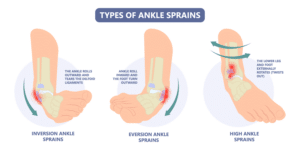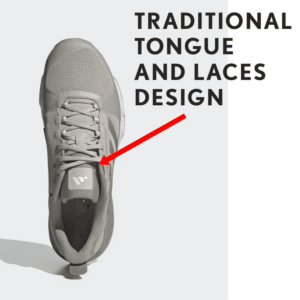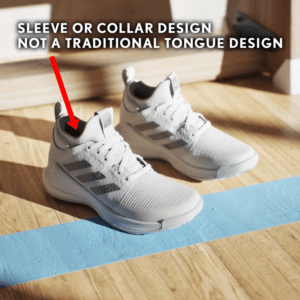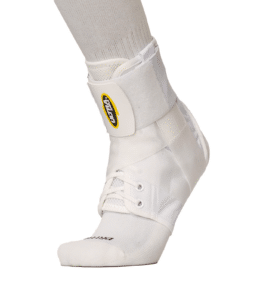Ankle Injury? Recover Faster – Get Back in the Game Sooner
If you’ve just suffered a second-degree (grade 2) ankle sprain, you’re likely dealing with swelling, bruising, and significant pain with every step. A sprain of this severity involves a partial tear in at least one of the ligaments that stabilize your ankle, making it difficult to walk or bear weight (MGB). Your medical team may have recommended a walking boot to immobilize your ankle, providing some relief from weight bearing pain. However, recent research suggests that even severe ankle sprains recover better and faster when exposed to protected movement. Regardless of your treatment plan, your main question remains: When can I start practicing and playing again?
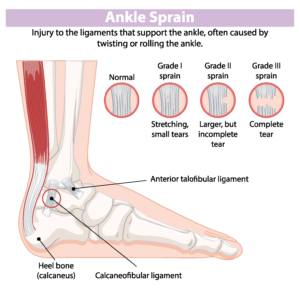
The Road to Recovery
After a week of therapy, your swelling and pain may have decreased enough to transition out of the boot. At this stage, introducing protected movement is key to optimizing your recovery. Movement improves circulation, delivering essential oxygen and nutrients to the injured joint, while also strengthening the muscles and tendons. This, in turn, helps you regain lost agility and gets you back to your sport faster (SIP).
Protected movement is made possible by wearing an ankle brace that allows your ankle and foot to move freely in all the natural ways-but restricts excessive movement to the already injured ligaments, muscles, and joint surfaces (SIP). Because your ankle is now unstable, you’ll need to stabilize it with a brace when you return to practice, allowing your ligaments to fully heal and protect against reinjury.
There are two types of ankle braces that can provide this stabilization: lace-up ankle braces and hinged (or semi-rigid) ankle braces. Lace-up braces, such as Ultra Ankle’s Ultra 360, offer support through a combination of laces and figure-8 straps, providing some flexibility while bracing the ankle. However, lace-up braces can lose their effectiveness as the fabric stretches and loosens over time, putting you at risk of re-injuring your ankle.
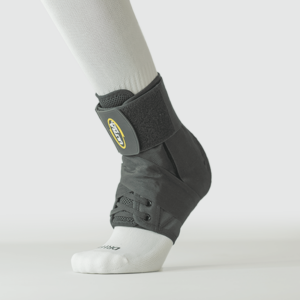
On the other hand, hinged ankle braces like the Ultra Zoom® help prevent your ankle from rolling side to side while still allowing the up-and-down movement needed to promote healing. This not only keeps you protected but also facilitates a quicker recovery (MVH). The Ultra Zoom’s patented hinge-cuff design offers an additional benefit: it helps prevent high ankle sprains, which are typically more painful and have a longer recovery period.
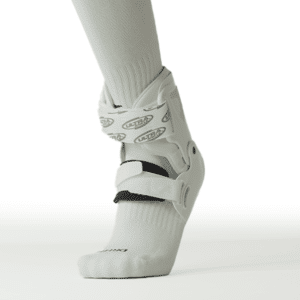
Recover Faster with the Ultra Zoom® Ankle Brace
The key to a quick and effective recovery is restoring your ankle’s range of motion and strength. The Ultra Zoom’s hinged-cuff design allows your ankle to move naturally, aiding rehabilitation while your ligaments heal. By maintaining normal ankle movement, the Ultra Zoom accelerates healing and rebuilds muscle strength, putting you on the fastest path to recovery. For more information you can watch our Ultra Zoom Product Features video.
Play Sooner – With Confidence
When you’re ready to return to practice or games, protecting your ankle from reinjury is critical. Your ankle is now more susceptible to twists and turns, increasing the risk of another sprain. The Ultra Zoom’s hinged-cuff design limits excessive inversion and rotation—movements that lead to ankle injuries. Its Performathane® soft, flexible shell forms a custom fit to your ankle using body heat, providing a secure, comfortable fit for all-day protection during every practice and game.
Ankle injuries are common in sports, but recurring injuries don’t have to be. By taking the right precautions with the Ultra Zoom Ankle Brace, you can stop the cycle of ankle injuries, and protect your pre-existing injury and play with confidence all season long.
